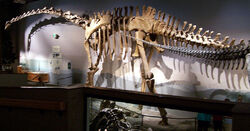| iSupersaurus
| ||||||||||||||||||
|---|---|---|---|---|---|---|---|---|---|---|---|---|---|---|---|---|---|---|
 Supersaurus skeleton, North American Museum of Ancient Life
| ||||||||||||||||||
| Scientific classification | ||||||||||||||||||
| ||||||||||||||||||
| ||||||||||||||||||
|
Supersaurus (meaning "super lizard") is a genus of diplodocid sauropod dinosaur discovered in the Upper Jurassic Morrison Formation of Colorado in 1972. It is among the largest dinosaurs known from good remains, possibly reaching 33 to 34 meters (108 to 112 ft) in length, and a weight of 35 to 40 tons.[1]
History

Life restoration of Supersaurus
The original fossil remains of Supersaurus yielded only a few bones: the shoulder girdle (type specimen BYU 5500) and a few neck vertebrae. This shoulder girdle (or scapulocoracoid) stood some 2.4 meters (8 ft) tall, if placed on end.
A new and much more complete specimen of Supersaurus, nicknamed 'Jimbo', has been found in Converse County, Wyoming. It is currently being excavated and its bones are being held at the Wyoming Dinosaur Center. Originally, it was thought that Supersaurus was related to the long-necked diplodocid Barosaurus (a member of the subfamily Diplodocinae), but the new specimen makes it clear that Supersaurus is actually more closely related to Apatosaurus (a member of the subfamily Apatosaurinae).[1]
Ultrasauros

A dorsal vertebra of a Supersaurus vivianae.
Paleontologist James A. Jensen, who described the original Supersaurus specimen, simultaneously reported the discovery of another gigantic sauropod, which would later be named "Ultrasaurus" macintoshi[2] (later re-named Ultrasauros macintoshi). The type specimen (the specimen used to define a new species) of Ultrasauros, being a backbone (dorsal vertebra, labeled BYU 9044), was later found to have come from Supersaurus. In fact, it probably belonged to the original Supersaurus specimen, which was discovered in the same quarry in 1972. Therefore, Ultrasauros became a junior objective synonym of Supersaurus, which had been named first and thus retains priority, and the name Ultrasauros was abandoned.[3]
Other bones that were found at the same location and originally thought to belong to Ultrasauros, like a shoulder girdle (scapulocoracoid, BYU 9462), actually belonged to Brachiosaurus, possibly a large specimen of Brachiosaurus altithorax.[3] The Brachiosaurus bones indicate a large, but not record-breaking individual, a little larger than the Brachiosaurus brancai in the Humboldt Museum of Berlin. Larger specimens of Brachiosaurus are known from the Tendaguru Beds of Tanzania, in east Africa.
Originally, these Supersaurus and Brachiosaurus bones were believed to represent a single dinosaur that was estimated to reach about 25 to 30 meters (80 to 100 ft) long, 8 meters (25 ft) high at the shoulder, 15 meters (50 ft) in total height, and weighing maybe 70 metric tonnes (75 short tons). At the time, mass estimates ranged up to 180 tons, which placed it in the same category as the blue whale and the equally problematic Bruhathkayosaurus.
Naming of Ultrasauros

The pelvis of a Supersaurus vivianae.
The naming of the chimeric Ultrasauros has a similarly complicated history. Ultrasaurus was the original choice, and was widely used by the media after the discovery in 1979. However, the name of a new species must be published in a scientific journal to become official.
Before Jim Jensen published his discovery in 1985, another paleontologist, Haang Mook Kim, used the name Ultrasaurus in a 1983 publication to describe what he believed was a giant dinosaur in South Korea. This was a different, much smaller dinosaur than Jensen's find, but Kim thought it represented a similarly gigantic animal because he confused a femur (leg bone) for a humerus (arm bone). While the logic of naming was incorrect, the Ultrasaurus from Kim's find fulfilled the requirements for naming and became regarded as a legitimate, if dubious genus. Thus, because Jensen did not publish his own "Ultrasaurus" find until 1985, Kim's use retained its official priority of name, and Jensen was forced to choose a new name (in technical terms, his original choice was "preoccupied" by Kim's sauropod). In 1991, at his suggestion, George Olshevsky changed one letter, and renamed Jensen's sauropod Ultrasauros.
When it was later discovered that the new name referred to bones from two separate, and already known species, the name Ultrasauros became a junior synonym for Supersaurus. Since the bones from the Brachiosaurus were only used as a secondary reference for the new species, Ultrasauros is not a junior synonym for Brachiosaurus. Since Supersaurus was named slightly earlier, the name Ultrasauros has been discarded in favor of Supersaurus.
Additional synonyms
Another diplodocid dinosaur found near the original Supersaurus quarry, known from a backbone (dorsal vertebra type specimen BYU 5750), was named Dystylosaurus edwini and is now also considered to be a specimen of Supersaurus vivianae. Hence, Dystylosaurus has also become a junior synonym of Supersaurus.[4]
Gallery
References
- ↑ 1.0 1.1 Lovelace, David M.; Hartman, Scott A.; and Wahl, William R. (2007). "Morphology of a specimen of Supersaurus (Dinosauria, Sauropoda) from the Morrison Formation of Wyoming, and a re-evaluation of diplodocid phylogeny". Arquivos do Museu Nacional 65 (4): 527–544.
- ↑ Jensen, J.A. (1985). "Three new sauropod dinosaurs from the Upper Jurassic of Colorado." Great Basin Naturalist, 45: 697-709.
- ↑ 3.0 3.1 Curtice, B., Stadtman, K., and Curtice, L. (1996) "A re-assessment of Ultrasauros macintoshi (Jensen, 1985)." Pp. 87-95 in M. Morales (ed.), The Continental Jurassic: Transactions of the Continental Jurassic Symposium, Museum of Northern Arizona Bulletin number 60.
- ↑ Curtice, B.; and Stadtman, K. (2001). “The demise of Dystylosaurus edwini and a revision of Supersaurus vivianae”, McCord, R.D.; and Boaz, D. (eds.): Western Association of Vertebrate Paleontologists and Southwest Paleontological Symposium - Proceedings 2001, 33–40.
External links
- "Whatever happened to 'Ultrasauros?, by Brian Curtice.
- "Why do mass estimates vary so much?", by Mike Taylor, 27 August 2002. (see footnote)
